News
Putting Women First
Previous article:
Helderberg Retirement Estate
Next article:
FLISP – The Missing Money

